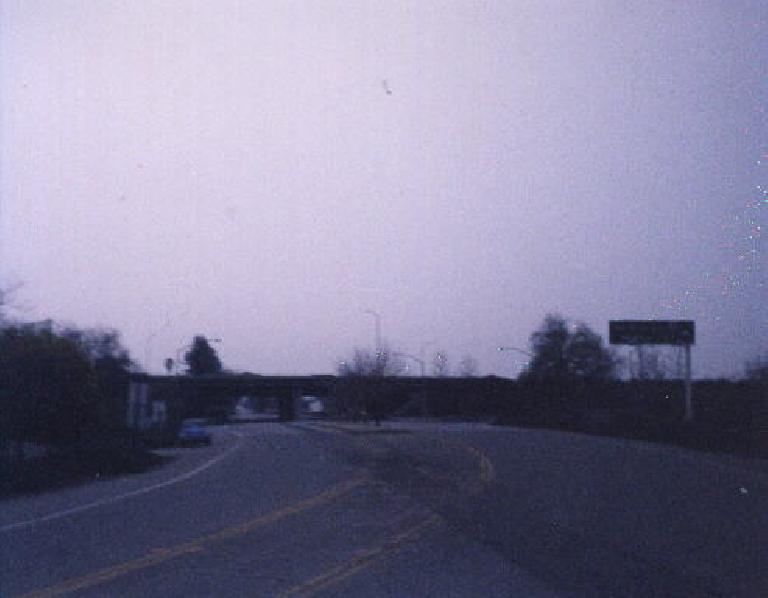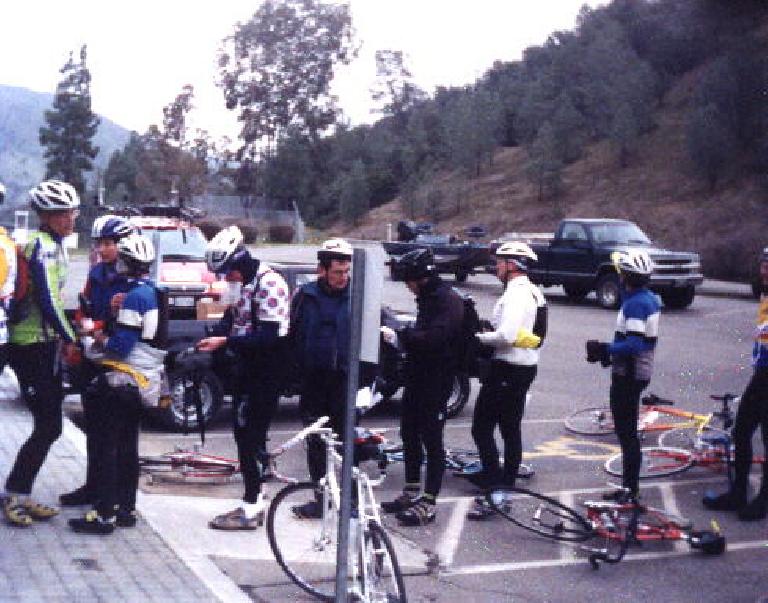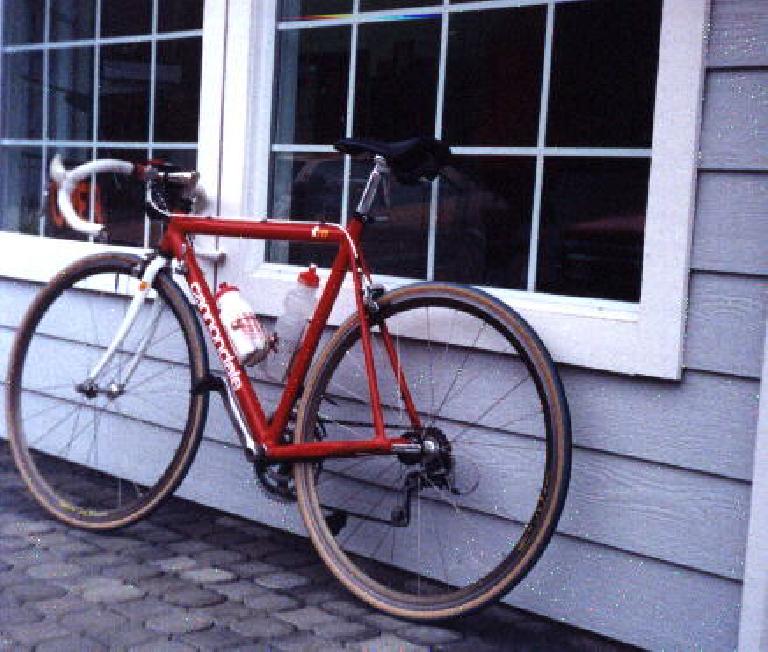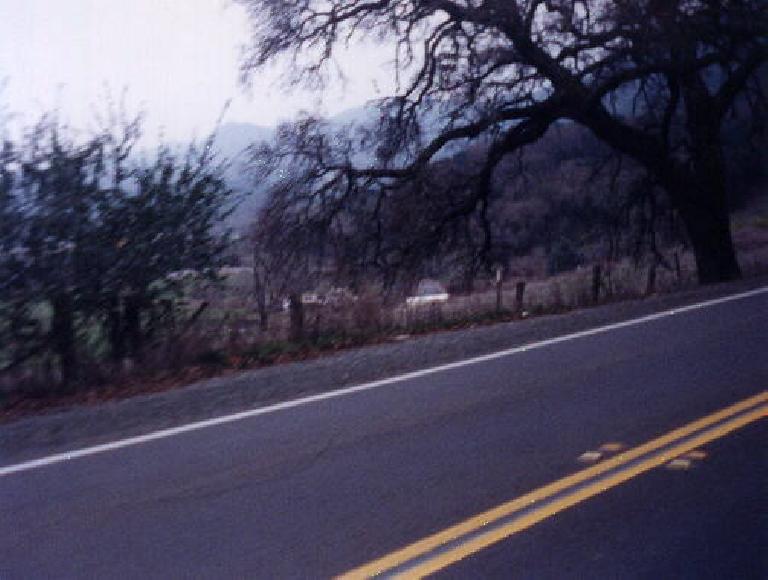Davis 200km Brevet, CA
These were my cycling goals for 1999: completing a third consecutive California Triple Crown, the CA Triple Crown Stage Race, and the One Thousand Mile Club. The Davis 200km Brevet provided an opportunity to do a triple-digit training ride before any of those events.
I first became interested in the Brevet Series after my friend Dan told me about it. It is a qualifying event for the quad-annual 1200-km Paris-Brest-Paris, the most prestigious amateur cycling event in the world. Maybe I’d do PBP in 2003, the next year it will be held. In the meantime, my focus was on this early season 126-miler.
The weeks prior to the event I prepared myself more thoroughly than ever. In addition to riding some significant miles during the weekends and some intervals on a trainer during the workweek, I did a rain ride with Dan to simulate conditions in Davis. That ride promptly persuaded me to invest in some rain gear for the first time in my life.
I also diligently did a bit of yoga every single night to increase my flexibility and maintain muscle suppleness. To not ignore the mental aspect of any activity, I practiced visualization before and during rides, as a tip from my friend Adrienne, an elite waterskier who is currently ranked 41st in the entire world.
Not an Auspicious Start
If the misfortunes of the 12 hours prior to the brevet were any indication, this was going to be a rough day. First of all, I was to make the traditional visit to my friend Pin-pin, along with my old cycling bud Ken, and stay over at Pin-pin’s place before waking up early for the ride.
But I was scatterbrained and had forgotten to write down her apartment address and phone number. So when I got to her apartment complex, which had at least 400 apartments, I had no idea how to find her.
After a call to her old roommates and Ken, I got the apartment number. But despite looking for it for at least half an hour, I still could not find it. Ken, fortunately, was more on top of things, and while he was on his way, he gave Pin-pin a call and told her I was wandering outside and asked her to look for me. While Ken and I were still on the phone, I turned around and there she was. Yay Pin-pin, she found me.
I got a good night’s sleep at her place and woke up at 5:30 a.m.—early enough to even do some email before the ride. Then I got to the start at 6:10 a.m.–that’s 50 minutes before the race would begin. Plenty of time, huh?
Well, it took 40 minutes to put on my shoes, neoprene booties, rain jacket, and headband; stuff my jersey with my camera, granola bars, a few dollars, and identification; and mount my lights on my bike. There were still ten minutes to go when I realized my Cannondale’s front tire was flat. It was feasible that I could fix it in 10 minutes, but I wasted too much time fumbling with a CO2 inflator, which I hadn’t used in a year or so.
Thankfully, I was able to borrow a floor pump from someone, but while I was putting on my lobster gloves and helmet, riders were given the go-ahead to start. The brevet had begun while I was still in the parking lot, alone
The Ride
The Chase
I took off from the parking lot at least two minutes behind everyone else, and hence when I started pedaling, the pack was already out of sight. But I knew the general direction they had ridden in, so I rode that way while hoping that I wouldn’t inadvertently go off course. Three minute passed and then six. Where was everyone?
I was about to pull out my map when, lo and behold, I saw cyclists up ahead, far in the distance. Now sure of where I was going, I gradually increased my speed to 22mph or so. I was feeling good.
I steadily reeled in the pack. I looked down the road: there had to be at least 100-200 cyclists forming a long train. It would be a few more minutes until I reached the caboose. But when I did, I was able to breathe a sigh of relief: I now had the benefit of the draft, where energy expenditure must be at least 20% less at speeds over 20mph.
To the Hills and Mile 63
Feeling relaxed and still strong, I spent the next hour gradually working my way to the lead pack of 20 riders. The pace was brisk, the terrain still flat, and the weather was still good—or at least dry. Twenty miles had passed, and the route was looking very familiar: I had ridden this way in several ultramarathon rides around Davis. We would reach the hills shortly.
Mile 25 was the first hill. Actually, it was more of a small knoll, one that looked trivial compared to the ones in the San Mateo and Santa Cruz mountains. But to my surprise, the pack immediately became fragmented, with the majority of riders dropping back. Almost instantly, I was surrounded only by 10 riders and had a clear view of the front. Cardiac Hill was ahead.
Despite its name, I’ve never thought Cardiac was a difficult climb. Something that probably helped every time, however, was a checkpoint located midway up it. This time the checkpoint would be at a lone store. I was pleased to be the 14th person to sign in—what a way to go from being off the back of the pack just a couple of hours ago. But with many cyclists filtering in, I decided this time I’d get a jump on the pack. I took off after refilling my water bottles and snapping a few pictures.
The next 30 miles had several descents and ascents. I remember distinctly getting passed by a female rider many times on the ascents, but I would whiz by her on the descents. We continued this yo-yo pattern for an hour, until… pssst. Another flat tire.
Fortunately, there was a support vehicle around the corner, and with the aid of the driver’s floor pump, I was back on the road. Nevertheless, I had lost 15 minutes, and had cooled off considerably. I still felt good all the way until the second checkpoint—the turn-around point and top of the ride—but from there my mood changed, and not for the better.
From Mile 60 to 90
By the time I left second checkpoint, the constant drizzle had turned into a dreadful downpour. The roads became slicker, the air became colder, and the outlook of the ride was grim. My rain gear had kept me warm and comfortable for the first half of the ride, but how would it fare in the second half?
All my clothing was saturated with water. This included my supposedly “waterproof” Pearl Izumi lobster gloves, and my two pairs of Coolmax socks covered by my cycling shoes and neoprene booties. My clear plastic rain jacket, while definitely waterproof, did not breathe, and a light film of moisture on the inside was visible from the outside. None of this had posed a big problem in the first half when I was climbing at lower speeds and burning more energy. Miles 60 to 90, however, were predominantly downhill. The first descents were particularly steep, too.
To try to stay warm, I resorted to applying the brakes while simultaneously pedaling. My hands were freezing and my heart rate was way down. Everyone seemed to be passing me, but I stuck to the same strategy: keeping lower speeds to reduce the chilling convective effects of the air currents around me, and pedaling to produce more body heat while preventing my the legs from stiffening up.
It was all essentially in vain. Normally I love downhill sections, where I can get in a tight aero-tuck while carving through turns in the roads at blistering speeds. But today was different as Mother Nature’s tears of winter came beating upon us. Safety, comfort, and warmth were now paramount in my mind. The first goal was attainable at the slow speeds I was going; the latter two were not with the gear I was having.
Memories of a Bay Area training ride a few weeks before came to mind. There I was wearing two less layers with no booties, full-fingered gloves, or waterproof rain jacket. It was raining just as hard, with winds of at least 40mph. Yes, I was COLD. To my surprise, however, I felt at least as cold on this ride despite the specialized rain gear, and I still had over 50 miles to go. What had I gotten myself into?
I tried to stop thinking about that. Instead, I tried to focus on getting from climb to climb, ascents being what I anxiously anticipated due to the reduced windchill and greater energy expenditure.
Hours later, I was back on Cardiac Hill, which I had climbed earlier from the other direction. And like in the morning, I would stop at the store that’s halfway up that hill. But this time I wouldn’t be stopping to sign in at a designated checkpoint. Instead, I entered the store to try to accumulate just enough body heat as possible so that I would be able to finish up the final 35 miles of the ride.
From Mile 90 to the End
The store must have been at least 30 degrees warmer than the outside air, not even taking wind chill into account. In the restroom, I rung out my gloves, ran hot water over my hands, and splashed warm water on my face. Then I munched on all the food I had and purchased some additional Power Bars, all while jumping up and down to stay warm.
Yet, after 20 minutes, I was still shivering. I looked outside, and the rain seemed to not only be coming down harder, but was travelling at a 45 degree angle. Wow.
“How the heck am I going to go out there and finish this thing if I can’t even stay warm inside here?” I asked myself. Briefly I pondered the possibilities. There were only two options: either ride back to the finish on my own power, or give in and take a SAG vehicle. Common sense told me I should take the latter option, lest I get hypothermia. But I’ve never abandoned a ride in all the years I have been cycling, and I didn’t want to quit now.
No SAG vehicle was in sight to tempt me anyhow. So it was back on the bike. I clipped into the pedals and braced myself for the cold air that would blast me while descending Cardiac Hill. All I could think about was one pedal stroke at a time, 90 times a minute. It is all I can remember now.
Finally, I was away from the hills and treacherous descents and among the flatlands of Aggie country east of Davis. Even this did not end the frigid suffering. The winds were stronger—especially when riding in the southbound direction—and the air was cold enough that I could see my breath. The rain, of course, still persisted.
I passed Mile 105, 110, and then 115. I tried to convince myself that 10 more miles really wasn’t far. But I was breathing so hard not from fatigue but to generate more heat on the inside of my cheeks via the friction caused by expelled warm air. I was also moaning with every breath, if only to symbolize the bicycling zombie I had turned into.
But as with every ride, there is an end. As I rode into Davis, all I could think about was throwing Canny into the back of the 944, turning the heater on full blast, and getting some warm Taco Bell food. It’s funny how one’s focus can change in 10 hours from finishing the ride in good time to just finishing intact, without hypothermia.
When the registration tables—and hence end of the ride—were in sight, I felt so relieved. I waited in line to sign the register, declaring that I had survived, somehow, some way. During this wait I was shivering uncontrollably and still breathing hard.
One of the cyclists in front of me couldn’t help but chuckle at my state, and I tried my best to smile.
“Way to go, you did it,” he said. Yes, I guess I did. And despite the suffering at the end, I know I’d do it again. Hopefully with Gore-Tex, though.
Ride Data
- 126 mi.
- 7:02 start, 16:57 finish = 9h55m
- Average Speed: 14.0 mph moving, 12.6 mph overall
- Max Speed: ~40 mph
- Total Climbing: 7,500 ft
Rating
(5=best)
- Scenery: 4
- Support/Organization: 4+ Surprisingly good for a low cost ride.
- Food: 3+ Well stocked.
- Weather: 1 Despite my new rain gear, I have never been so cold for so long in my life.
- Relative Difficulty: 3
- Overall Rating: 3. A fun and beautiful ride dampened by bad weather.







